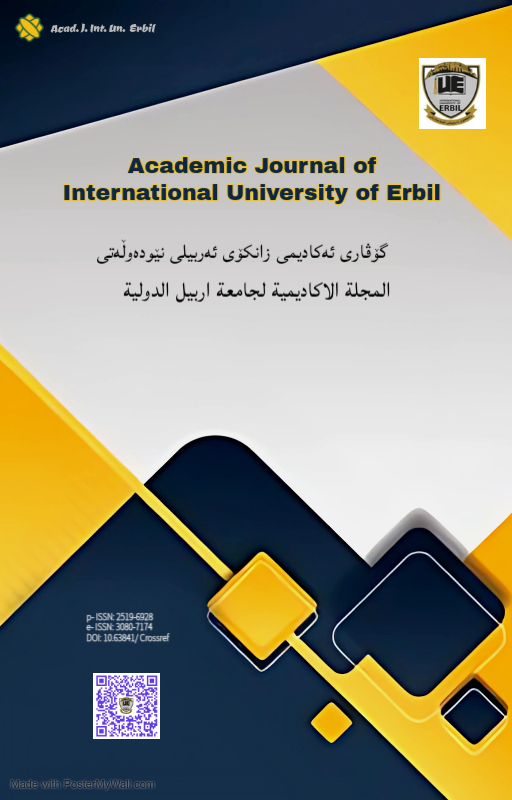The Effect of Liquidity Risk Management on the Bank Performance: Evidence from Iraqi banks
Effect of Liquidity Risk Management on the Bank Performance
DOI:
https://doi.org/10.63841/iue22582Keywords:
Liquidity, Bank performance, ROA, and Sulaymaniyah city.Abstract
The main objective of this paper is to study the effect of liquidity risk management on the profitability of commercial banks in Iraq during the time period (2020-2021). A descriptive survey design was adopted. The target is 4 private commercial banks listed on Iraqi Stock Exchange operating in Sulaymaniyah City. The liquidity indicator is the Liquidity Ratio while return on assets (ROA) were the proxy for profitability. Therefore, the dependent variable is bank performance which is measured by return on asset (ROA) and the independent variable is the Liquidity Ratio.
The empirical results, show that an increase in the liquidity ratio of leads to an increase in profitability. Furthermore, the findings illustrate that liquidity risk has a positive significant association with bank profitability.
The researchers recommend, that there is a need for optimum utilization of the available liquidity in various aspects of investment in order to increase the banks' profitability, and banks should adopt a general framework of liquidity management to assure sufficient liquidity for executing their operations more efficiently, and they should initiate an analytical study of the evolution rates of liquidity and their ability to achieve a balance between sources and uses of funds.
References
A. Alshatti, "The effect of the liquidity management on profitability in the Jordanian commercial banks," Int. J. Bus. Manag., vol. 10, no. 1, pp. 62-71, 2015.
M. A. Eljelli, "Liquidity-profitability tradeoff: An empirical investigation in emerging market," Int. J. Manag., vol. 14, no. 2, 2004.
P. Rose and S. Hudgins, “Bank Management and Financial Services,” 9th ed. Singapore: McGraw Hill, 2013.
N. A. Fatah, H. A. Hamad, and K. S. Qader, “The role of internal audit on financial performance under IIA standards: A survey study of selected Iraqi banks,” Qalaai Zanist Journal, vol. 6, no. 2, pp. 1028-1048, 2021.
H. M. Jadah, M. H. Alghanimi, N. S. Al-Dahaan, and N. H. Al-Husainy, “Internal and external determinants of Iraqi banks profitability,” Banks Bank Syst., vol. 15, no. 2, pp. 79-93, 2020.
N. A. Fatah, G. M. D. Omer, H. A. Bayz, L. E. Karem, K. H. Ahmad, W. O. Mustafa, et. al., “Conceptualization of the capital maintenance”. British Journal of Interdisciplinary Research, vol. 2, no. 3, pp. 134-148, 2025.
H. Abdullah, and N. Fatah,“The effect of the COVID-19 pandemic on capital stock gains: evidence of large stock exchanges”. In Third scientific international conference of Al-Mustansiriyah University, Baghdad, pp. 427-445), 2020.
N. A. Fatah, K. A. AbdulRahman, and F. P. Ali, “The Effects of Money Laundering on The Performance of Banks: An Analytical Study of a Sample of Iraqi Banks,” International Journal of Scientific Research and Technology, vol. 2, no. 3, pp. 1-9, 2025.
M. Godfrey, "Liquidity and bank performance," Int. Bus. Econ. Res. J., vol. 14, no. 3, pp. 453-462, 2015.
N. A. Fatah, "Factors affecting customers’ decision for taking out bank loans: A case of Sulaymaniyah city commercial banks," M.S. thesis, Near East University, 2018.
U. Md Reaz, M. A. R. Syed, and D. Saurav, "Liquidity risk and performance: A study on the banking sector of Bangladesh," Bus. Rev. J. Bus. Admin. Discipline, vol. 11, no. 182, pp. 35-42, 2016.
K. Zidan, “Impact of liquidity management on the profitability of banks operate in Palestine,” Int. J. Bus. Soc. Sci., vol. 11, no. 1, pp. 12-17, 2020.
B. Erika and M.-K. Raimonda, “Liquidity risk and its management in Lithuanian banking system,” Mokslas–Lietuvos ateitis/Science–Future of Lithuania, pp. 64-71, 2014.
A. Olagunju, O. D. Adeyanju, and O. S. Olabode, “Liquidity management and commercial banks’ profitability in Nigeria,” Res. J. Finance Accounting, vol. 2, no. 7/8, pp. 24-39, 2011.
A. Arif and A. Anees, “Liquidity risk and performance of banking system,” J. Financial Regul. Compliance, vol. 20, no. 2, pp. 182-195, 2012.
M. Ramzan and M. I. Zafar, “Liquidity risk management in Islamic banks: A study of Islamic banks of Pakistan,” Interdiscip. J. Contemp. Res. Bus., vol. 5, no. 12, pp. 199-215, 2014.
A. Golovkova, J. Eklof, A. Malova, and O. Podkorytova, “Customer satisfaction index and financial performance: A European cross-country study,” Int. J. Bank Mark., vol. 37, no. 2, pp. 479-491, 2019.
D. Diamond and R. Rajan, “Liquidity risk, liquidity creation, and financial fragility: A theory of banking,” J. Political Economy, vol.109, no.2, pp.287-327,2001 [Online]. Available: http://www.jstor.org/stable/10.1086/319552?seq=1#page_scan_tab_contents
H. A. Abdullah, H. G. Awrahman, and H. A. Omer, "Effect of working capital management on the financial performance of banks: An empirical analysis for banks listed on the Iraq stock exchange," Qalaai Zanist Journal, vol. 6, no. 1, pp. 429-456, 2021.
K. Zaghdoudi, "The effects of risks on the stability of Tunisian conventional banks," Asian Econ. Financial Rev., vol. 9, no. 3, pp. 389-401, 2019.
Downloads
Published
Issue
Section
License
Copyright (c) 2025 Academic Journal of International University of Erbil

This work is licensed under a Creative Commons Attribution 4.0 International License.












